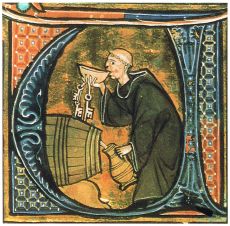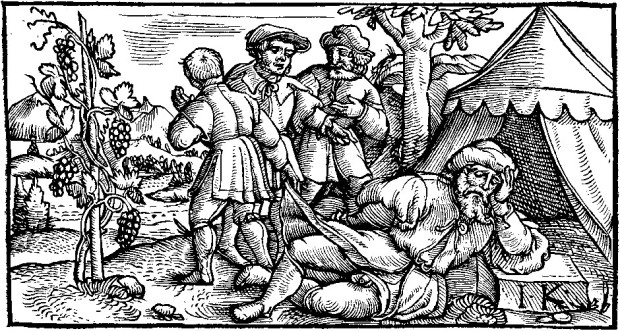Yesterday, I finished the second day of a three-day copy editing temp job. The office has a cappuccino machine. It’s obviously not the best cappuccino I’ve ever had, but I’ve never before been able to have as much cappuccino as I want, whenever I want. I’ve had to make them using decaf to avoid spending the entire day with the jitters.
This has gotten me thinking about beverages in Creation and other fantasy worlds.
One might divvy up beverages (or any foodstuffs, really, but we’ll stick with drinks here) in fantasy settings into the following categories:
- Those with unnatural effects, such as Ent-draught or the Pan-Galactic Gargle Blaster, made from unnamed or invented raw materials. These are basically magic potions and are typically used as plot devices.
- The merely imaginary, such as Blue Ruin or Slurm. An exotically named mystery beverage can add a touch of the fantastical to a scene. The disadvantage of imaginary drinks is that they lack context; the reader doesn’t actually know what they taste like, and if you spell out the flavor you’re probably describing something similar to a real drink.
- Placeholders such as punge (the Archonate‘s version of coffee) or scumble (the Discworld’s take on applejack). These fill in for real drinks when you want your setting to feel alien or otherwise detached from the real world, where you feel that just saying “coffee” will snap your readers out of your imaginary panorama.
- Real drinks consumed on Earth, or at least made from real Earth substances. The advantage here is that the reader or player is familiar with the beverages in question, or at least can easily imagine what they’re like.
Pan-Galactic Gargle Blaster recipe“Take the juice from one bottle of that Ol’ Janx Spirit. Pour into it one measure of water from the seas of Santraginus V. Allow three cubes of Arcturan Mega-gin to melt into the mixture (it must be properly iced or the benzene is lost). Allow four litres of Fallian marsh gas to bubble through it (in memory of all those happy Hikers who have died of pleasure in the Marshes of Fallia). Over the back of a silver spoon float a measure of Qualactin Hypermint extract, redolent of all the heady odours of the dark Qualactin Zones. Drop in the tooth of an Algolian Suntiger. Watch it dissolve, spreading the fires of the Algolian suns deep into the heart of the drink. Sprinkle Zamphour. Add an olive. Drink… but very carefully.” — Douglas Adams, The Restaurant at the End of the Universe |
Like most fictional settings, Creation draws primarily from the last category.
Note that our modern world gives us unprecedented access to foodstuffs from the four corners of the globe. Even now, Westerners are learning the flavors of formerly inaccessible foodstuffs like açaí berries. In a fantasy setting, you’ll often have a world or a written-up section of the world that’s based on a particular real-world culture and time period. For such places you’ll want to limit what’s available to its Earthly equivalent.
Creation is a bit different in that it’s a vast setting meant to encompass pretty much everything that a given Storyeller might find interesting from Earth’s history. Moreover, it’s set after the fall of a world-spanning hegemonic culture which had access to every corner of the world—and proceeded to shape new ecologies from the chaos at world’s edge. Thus, foodstuffs and their raw materials need not be limited to specific parts of the world, as the folk of the First Age transplanted such things everywhere they might be capable of growing, much as travelers on Earth have done for millennia (and with increasing effectiveness in recent decades).
That said, instead of saying what people drink here or there, it’s probably better to look at various types of beverage and suggest what parts of the world they are consumed in, and how preparation and consumption might differ from region to region. For today, I’ll stick to alcoholic beverages; this post is long enough as it is and I’d like to get it posted before dinner. (If this post interests you, dear reader, I’ll work up a second post about non-alcoholic drinks at a later time.)
But first, a note on water. While many cultures historically favored various alcoholic beverages for reasons of flavor, health, or tradition, societies that had access to clean water drank more of it than anything else. It’s cheap and easy to obtain, and so it’s drunk to some extent nearly everywhere. But pure water isn’t always easily available in sufficient quantities, and contaminated water can result in all manner of diseases—cholera, dysentery, typhoid fever. This calls for purification methods such as boiling, filtration, or the use of various additives or apparatus. But the most common way to avoid harm from tainted water is to drink some other beverage.
Beer: Historically, beer was critically important to early Bronze Age societies in the Fertile Crescent and the Mediterranean. Thick and heavy to the point that it’s been compared with gruel, it required the use of reeds as drinking straws to get past a heavy layer of floating grain debris. It also spoiled relatively quickly. Such beers likely appear in Near Southern societies. The bitter flavoring in modern beers comes from hops, which is only known to have been put to this purpose for about a millennium. Creation’s beers, like real-world beers predating the use of hops, are likely to use a broader range of roots, leaves, and flowers as flavoring and bittering agents. These most likely appear in the North and East, where you can find societies drawing on a range of medieval European cultural elements.
Wine: Traditionally made in warm climates conducive to viticulture, the real-world history of grape wine in the Mediterranean maps best to the near South, the southern Blessed Isle, and parts of the Scavenger Lands. Wine appellations (geographic designations of wine types, like our modern champagnes and burgundies) can be traced back as far as imperial Rome, so I’d expect the Realm to have a similar system. This includes the possibility of extirpated appellations like the famous Caecuban, such that the last remaining barrels or amphorae are worth a queen’s ransom. Lower-quality wine, to be consumed by the poor and by slaves, was squeezed out through additional pressings. Wine could be flavored with herbs and spices, stored in resinous containers to produce retsina, or sweetened with honey, boiled must, or lead(!). Overall, wines tended to be sweet and strong—often to the point that they were watered down when served—and could be aged for years or even decades.
Sake: Likely most common on the Blessed Isle, in the Southwest, and in the Scavenger Lands, where rice production is common and where cultural tropes coincide with those of real-world societies that made and consumed rice wine.
Mead: We normally think of this as a Norse beverage, but while it’s especially important in climates that don’t support grapes, it can be created anywhere that bees can be found, and indeed by semi-nomadic peoples gathering honey from wild hives. Historically it was made and consumed in places from China to Rome, Ethiopia to South Africa. Mead most likely dominates the alcoholic palates of many Northern cultures, some far Eastern tribes, and even the occasional Western island lacking in fruits and grains.
Distilled spirits: Fortified beverages such as whiskey and brandy only go back about a thousand years, but that’s early enough to fit into certain parts of Creation. You can doubtless find shochu in Lookshy, whisky in Whitewall, and coconut arrack in Abalone.
Other alcoholic beverages: There’s a broad range of real-world alcoholic drinks that you won’t find at your corner liquor store. In the West and Southwest, sap from coconut palm flowers is fermented into “palm wine,” its milky hue often reddened by steeped tree bark. The horse-tribes of Marukan ferment mare’s milk to make kumiss, while apothecaries in Nexus steep venomous snakes in rice wine. Lychee wine is drunk in the Imperial City, perry in Chanos, cider in Whitewall, pulque in Ember, chicha in Ixcoatli, and banana beer in Faxai-on-the-Caul.
 Local variations: “Beer” and “wine” and “mead” and their ilk are merely broad categories, each of which encompasses an enormous range of variants. Each culture puts its own spin on its beverages with distinctive ingredients and brewing techniques. Think of the differences between ales and lagers, or the innumerable distinct species and terroirs of wine grapes, coffee beans, and tea leaves, or the endless possibilities for adding spices and other flavoring agents, or aging in different sorts of containers. Sometimes the result may be hard to categorize—would the ancient Chinese beverage made from rice, honey, grapes, and hawberry best be described as a beer, mead, or wine? I recommend that interested players and Storytellers perform their own research.
Local variations: “Beer” and “wine” and “mead” and their ilk are merely broad categories, each of which encompasses an enormous range of variants. Each culture puts its own spin on its beverages with distinctive ingredients and brewing techniques. Think of the differences between ales and lagers, or the innumerable distinct species and terroirs of wine grapes, coffee beans, and tea leaves, or the endless possibilities for adding spices and other flavoring agents, or aging in different sorts of containers. Sometimes the result may be hard to categorize—would the ancient Chinese beverage made from rice, honey, grapes, and hawberry best be described as a beer, mead, or wine? I recommend that interested players and Storytellers perform their own research.
Finally, a quick note on beverage-making and religion. Alcoholic beverages such as beer don’t always turn out as intended due to the interaction with yeasts and other biological agents in the fermentation process; as such, brewing in Creation doubtless involves a range of prayers to ensure that the beverage comes out as intended, without spoilage or unpleasant flavors. As in Mesopotamia or certain medieval European localities, some places will combine the two roles outright by putting priests or monks in charge of brewing.

Where’s the Rum gone?
More specifically this was pretty interesting. I’d like to hear about the non-alcholic beverages too.
Glad you enjoyed the post! As for rum, it’s such a recently developed drink that I didn’t include it, but it’s not unreasonable to include it in the West where thematically appropriate.
As per Masters of Jade, wouldn’t it also be reasonable to include it in the Southeast, where there’s lots of sugarcane plantations and such?
> As per Masters of Jade, wouldn’t it also be reasonable to include it in the Southeast, where there’s lots of sugarcane plantations and such?
I don’t see why not!
It feels weird to me for you to put cider alongside the provincial oddities.
I mean, I don’t drink it personally, but it’s very familiar.
> It feels weird to me for you to put cider alongside the provincial oddities.
I elided cider (and perry, which seems to have a similar pedigree) because my initial research didn’t turn up a lot of information. Maybe I’ll edit it in later.
I love this post, partly because one of my players wants to play a master brewer once 3rd edition comes out
This is wonderful inspiration. Thank you! One of my players had her Changing Moon start a brewery and distillery in Nexus and now I can help her with many more flavorful details.
Just about any fruit or starchy root can be made into alcohol, so I’m sure that there are tropical fruit-“wines” and root-“beers” and I expect banana beer (which does involve grain) to be brewed in Wavecrest and the Southwest. Millet beer may be common in the East or Blessed Isle, oat beer in the Near North, sorghum and millet beers in the South and Southeast. Sorghum plus teff make for tella which is probably grown somewhere in the Southeast. Northeasterners might make wine from northern berries.